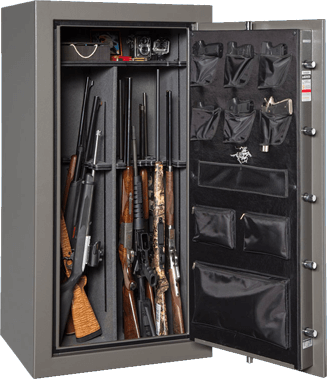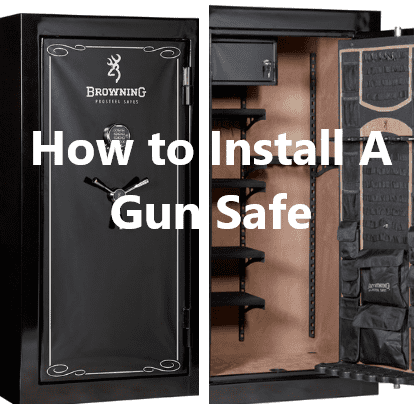When it comes to obtaining a gun safe, installation can be a little intimidating because they’re large, heavy, and tough to move. Don’t worry! We know that this can be an issue, and we hope that some of the information in our official, easy tutorial will assist you in figuring out how to install the safe without forgetting anything.
Where Should You Put A Safe?
It’s up to you whether you keep the safe in a certain location, but there are a few things to keep in mind.
A gun safe that takes an excessive amount of time to access may not be utilized very often. Convenience should be considered while installing a gun safe, as long as it is in a secure location. If you’re having trouble getting into your gun safe, whether it’s because of locks or because you’re looking all around your house for it, it’s possible that it’s not being used for its intended function.
Larger gun safes are frequently placed in a cellar, basement, or on the ground level, often in a corner. The safe’s size, the door open size to ensure you don’t hit anything when opening the safe, and the floor are all things to consider, as you can see below. If you discover a location that meets all of these requirements, make sure the safe can get there. Is it possible to get it through your house’s doors and within the height restrictions? If it does, keep reading to find out what else you should think about once you’ve gotten through this phase. You can also store your guns close to your bed. See which is the best large under bed gun safe.
You should also think about the humidity in your area before placing the safe. Moisture in your safe is one of the most common concerns, and it can lead to safe lock failure, rusting, and mechanical problems with your firearms. With that said, you can purchase dehumidifiers, but simply placing the safe in the proper location can assist.
Garages and basements are typically not climate-controlled places with air conditioning or other amenities, which means you may need to relocate depending on where you live in the United States. You might be lucky and have some form of thermal mass to assist keep the humidity in check, but finding a technique to avoid it is critical because it can be the silent murderer of your weaponry.
You Need The Right Tools
Installing your safe may necessitate the use of specific tools. The majority of gun safe manufacturers will include instructions on how to properly drill down and install your safe. However, there are certain generic instructions and guides, such as this one, that will assist you in properly installing the safe. We recommend enlisting the help of a few friends or family members to move the safe. We also recommend using a dolly to make transferring the safe more convenient.
Additionally, if you intend to mount your safe or secure it to the ground, you will require a powerful drill and all necessary drill bits to secure the safe to the ground. Most safes come with pre-drilled holes in the steel, so metal drill bits aren’t required. Most manufacturers recommend hand tightening the bolts using a wrench to eliminate overtightening, as they are rather long and thick, and if placed incorrectly or with difficulty, they may create a few problems.
Once you have everything you need, you can begin moving your safe into your home and getting everything ready.
How to Install A Gun Safe
When it comes time to actually install the safe, you’ve most likely already found the spot that’s right for it. If you haven’t already, it’s probably a good idea to get it set up, ready to install, or just in the correct spot. The safe maker may supply instructions on how to fit the safe with the proper measurements so that you can pre-drill your holes before moving it into place. If not, simply measure the distance between each hole and the size of the bolts that will be placed with the safe with a measuring tape.
Because you don’t want to oversize the holes, pilot holes can be drilled. Otherwise, your positioning will not work, and the safe may need to be changed to fit somewhere else.
After you’ve found out where the holes need to be bored, drill the pilot holes and double-check your work by moving the safe into place before bolting it down or into whatever location the safe will be.
Once the safe is in place, you can anchor it and drill the bolts to ensure it won’t move in the event of an earthquake, or simply to add a layer of protection to ensure no one can move it. If you have a concrete slab floor, verify the floor warnings before drilling since some concrete slabs, known as post-tension concrete slabs, cannot be drilled. This is due to the high-strength steel cables that run through them, which are designed to withstand pressures of thousands of pounds. When a cable is damaged, it will rip right through the concrete and destroy anything that gets in its way.
It’s also worth noting that if you’re drilling into concrete, the gun safe manufacturer should certainly offer concrete anchors. If this isn’t the case, it’s highly suggested that you go out and purchase additional concrete anchors with 12″ bolts. Otherwise, you might run into issues later. Additionally, you should use galvanized or zinc-plated steel because concrete might release moisture, which you don’t want to be concerned about while drilling into your floor.
Once the safe is in position and the bolts are drilled, it will no longer wobble in an earthquake and will most likely not be able to be moved, but you can always try it to be sure. As you now know how to install your gun safe, see the best home gun safes under $1000.
Things To Remember
Get Help
Getting assistance with moving and installing the safe is definitely a smart call and you should really rely on others to help get the assignment finished. Even having someone pass you the drill will assist you in the most basic of situations. Not only that, but having someone to assist you can make moving it much easier, and having two sets of eyes on a project is preferable to having just one, in case someone makes a mistake. You can also flaunt your armament, which, let’s face it, who doesn’t want to do?
Measure Things First
People don’t examine the size of the safe or the best location for the safe, which is the most typical reason for refunded gun safes. Using a measuring tape to the supermarket and around your house will only take you about 5 minutes and will save you a lengthy trip and explanation. You may also want to examine your floor as part of these checks to ensure that the safe can be transported, anchored, or positioned where you want it.
Don’t Use The Wall and Floor Bolts Together
Although your safe may provide bolts for both floor anchors and wall anchoring, you may not want to use both. Although more secure, you risk having worse issues, such as a misaligned door mechanism. This can happen when metal twists or warps, causing parts to misalign and presenting a major problem with the lock mechanism.

Jerry Miculek is an experienced firearms and optics expert. Guns are not just a hobby for him, they are his passion and life. You can learn more about Jerry on our About us page.

